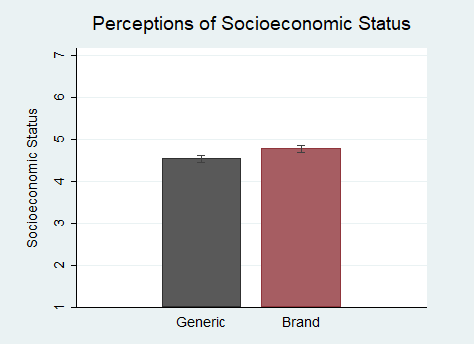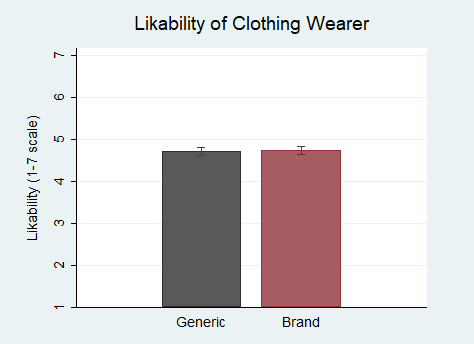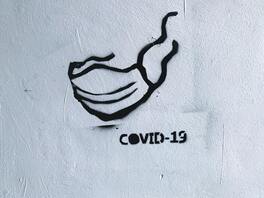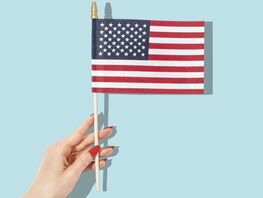Overview
Expensive clothing has been used a signal of socioeconomic status for thousands of years. In recent times, businesses have attempted to impart the same effect on certain name brand clothing labels. But do people actually perceive the wearers of these brands as higher in socioeconomic status?
Brands differentiate on more than just price. In a previous experiment, we found that Mac users are perceived to be more sophisticated than PC users. So, taking our brand psychology logic a step further, might wearing popular name brand clothing produce other psychological effects, such as increased likability?
The Experiment
We recruited 400 people from Amazon Mechanical Turk to view a vignette involving a hypothetical new person joining a group of friends for dinner and a photo of this new person wearing a jacket that either showed a high-end brand logo or no brand logo (randomly assigned). The brand North Face was chosen because their clothing is well-known and high-priced, but not so high-priced that few people wear it. We then asked participants to rate our jacket-wearer’s likability and perceived socioeconomic status.
Participants were told to “Imagine you’re out to dinner with a few friends and someone you haven’t met before. The new acquaintance (pictured below) introduces himself as Chris.” Below this text, participants saw one of two photos of a model wearing a North Face jacket with the logo either visible or edited out.
Participants were then asked “How much do you think you’d like Chris? (1 = Not at all, 7 = Very much)” and “Relative to other people in the U.S. what do you think Chris’ socioeconomic status is, in terms of money, education, and respectable job?” Both questions used a 1-7 scale.
At the end of the survey, we asked participants “Are you familiar with the clothing brand North Face?” (answer options “Yes,” “No,” Not sure”) to ensure we’d chosen a brand that people know. We also surveyed participants for their gender, age, education, and income to test whether the results differed across these demographics, particularly the latter two.
Results
Approximately 80% of our sample were familiar with the North Face, which provides evidence that we’d chosen a well-known brand for our experiment.
First, we analyzed whether wearing the North Face jacket with logo affected Chris’ perceived socioeconomic status (SES). An independent samples t-test revealed a small but statistically significant difference, such that Chris’ SES was perceived to be slightly higher when he was wearing the North Face jacket (avg. = 4.79) relative to the generic jacket (avg. = 4.56), (p = 0.043).
Expensive clothing has been used a signal of socioeconomic status for thousands of years. In recent times, businesses have attempted to impart the same effect on certain name brand clothing labels. But do people actually perceive the wearers of these brands as higher in socioeconomic status?
Brands differentiate on more than just price. In a previous experiment, we found that Mac users are perceived to be more sophisticated than PC users. So, taking our brand psychology logic a step further, might wearing popular name brand clothing produce other psychological effects, such as increased likability?
The Experiment
We recruited 400 people from Amazon Mechanical Turk to view a vignette involving a hypothetical new person joining a group of friends for dinner and a photo of this new person wearing a jacket that either showed a high-end brand logo or no brand logo (randomly assigned). The brand North Face was chosen because their clothing is well-known and high-priced, but not so high-priced that few people wear it. We then asked participants to rate our jacket-wearer’s likability and perceived socioeconomic status.
Participants were told to “Imagine you’re out to dinner with a few friends and someone you haven’t met before. The new acquaintance (pictured below) introduces himself as Chris.” Below this text, participants saw one of two photos of a model wearing a North Face jacket with the logo either visible or edited out.
Participants were then asked “How much do you think you’d like Chris? (1 = Not at all, 7 = Very much)” and “Relative to other people in the U.S. what do you think Chris’ socioeconomic status is, in terms of money, education, and respectable job?” Both questions used a 1-7 scale.
At the end of the survey, we asked participants “Are you familiar with the clothing brand North Face?” (answer options “Yes,” “No,” Not sure”) to ensure we’d chosen a brand that people know. We also surveyed participants for their gender, age, education, and income to test whether the results differed across these demographics, particularly the latter two.
Results
Approximately 80% of our sample were familiar with the North Face, which provides evidence that we’d chosen a well-known brand for our experiment.
First, we analyzed whether wearing the North Face jacket with logo affected Chris’ perceived socioeconomic status (SES). An independent samples t-test revealed a small but statistically significant difference, such that Chris’ SES was perceived to be slightly higher when he was wearing the North Face jacket (avg. = 4.79) relative to the generic jacket (avg. = 4.56), (p = 0.043).
We did not, however, find a significant difference in likability (p = 0.794). Chris was liked about equally when wearing the North Face jacket (avg. = 4.75) or the generic jacket (avg. = 4.72). We did not find any interactions with either result and participants’ age, gender, income, or education levels.
Conclusion
In conclusion, don’t throw out your wardrobe just yet. Overall, the results suggest that high-priced brand-name clothing like the North Face can impart a small status boost, at least in the form of socioeconomic status. But similar to our name brand shoes experiment, it is not sufficient to boost the wearer’s likability. Looks like you might actually need a personality for that.
Methods Note
We used an independent samples t-test to test for significant differences in perceptions between our two experimental conditions. For significant differences, the difference between the two groups' averages would be large and its corresponding “p-value” would be small. If the p-value is less than 0.05, we consider the difference statistically significant, meaning we'd likely find a similar effect if we ran the study again with this population. To test for significant interactions between the main results and participant demographics, we used OLS regression analyses with interaction terms.
Methods Note
We used an independent samples t-test to test for significant differences in perceptions between our two experimental conditions. For significant differences, the difference between the two groups' averages would be large and its corresponding “p-value” would be small. If the p-value is less than 0.05, we consider the difference statistically significant, meaning we'd likely find a similar effect if we ran the study again with this population. To test for significant interactions between the main results and participant demographics, we used OLS regression analyses with interaction terms.
Popular Experiments
COVID MasksDoes wearing a COVID mask affect how others think of you?
|
Video GamesAre video games more enjoyable than board games?
Does age or gender matter? |
Zero-Sum PoliticsDo Democrats or Republicans view society as win-lose?
|





